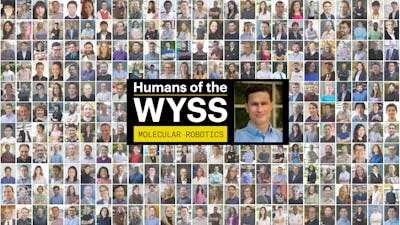
The Humans of the Wyss series features members of the Wyss community discussing how they think about their work, the influences that help shape them as scientists, and their collaborations at the Wyss Institute and beyond.
In this installment of our Molecular Robotics Edition, we talk to Staff Scientist Tom Schaus, M.D. Ph.D., about his path to the Wyss Institute and how he envisions his research impacting the world.
What drives you?
I’ve always enjoyed the process of identifying problems that are worth working on and plausible to solve – it’s fun to think outside of the box and figure out how to solve them. I kind of fell into this field. I started as a mechanical engineer and then completed an M.D./Ph.D. program with a focus on cell biology. I wanted to work in biophysics but also to do something involving engineering.
I read Peng Yin’s 2008 Nature paper, Programming biomolecular self-assembly pathways, and was in awe of his work and how it bridges the gap between engineering and biology. I called him up and he gave me a job.
When I joined the lab 10 years ago, we had the intuition that this was important work, but we weren’t quite sure what would come of it. The incredible discoveries that have been made since I’ve been here, including DNA origami, are proof of the faith and intuition that have brought us to this point.
The incredible discoveries that have been made since I’ve been here, including DNA origami, are proof of the faith and intuition that have brought us to this point.
You’re working on Auto-cycling Proximity Recording (APR), tell us more.
Auto-cycling Proximity Recording (APR) is a method for detecting individual biomolecular proximities, or interactions, and recording that information in DNA for later readout. It essentially takes advantage of the enormous toolbox available for reading and writing DNA to make tiny, super-precise recorders. Our long-term goal is to record biological processes with unprecedented precision.
Share with us some of the challenges you’re facing.
For most of history we’ve been working at macroscopic scales, where missing a billion molecules one way or another would go unnoticed. Observation and manipulation at the molecular scale comes with very different rules and phenomena – and subsequent challenges. But it’s an important new frontier, and we think a closer look will answer a lot of questions.
So, how do you envision APR impacting the world?
As a systems biology tool, APR will enable us to better understand how cells, tissues, and organs work in health and disease. We hope that this tool will help systems biologists gain a more in-depth understanding of cells through predictive modeling. We hope that eventually these methods can be used in the clinic to personalize treatment.
